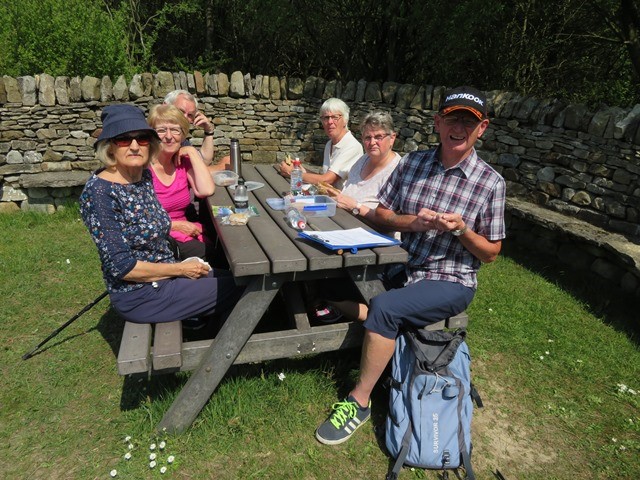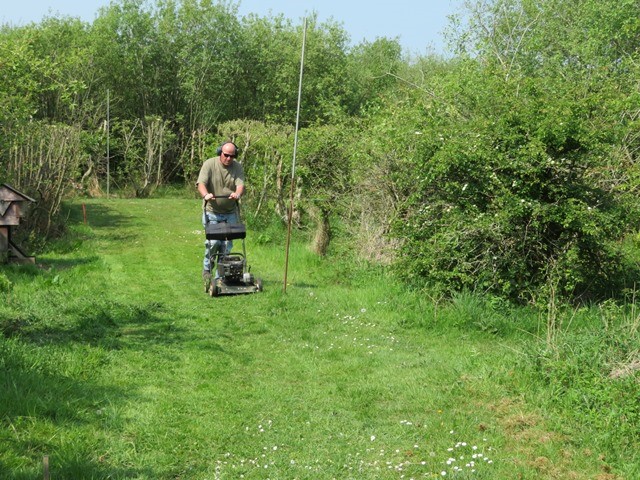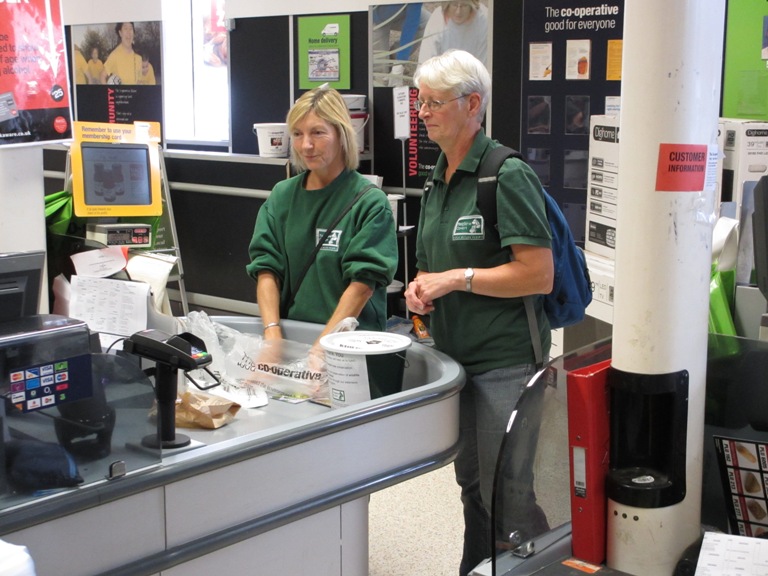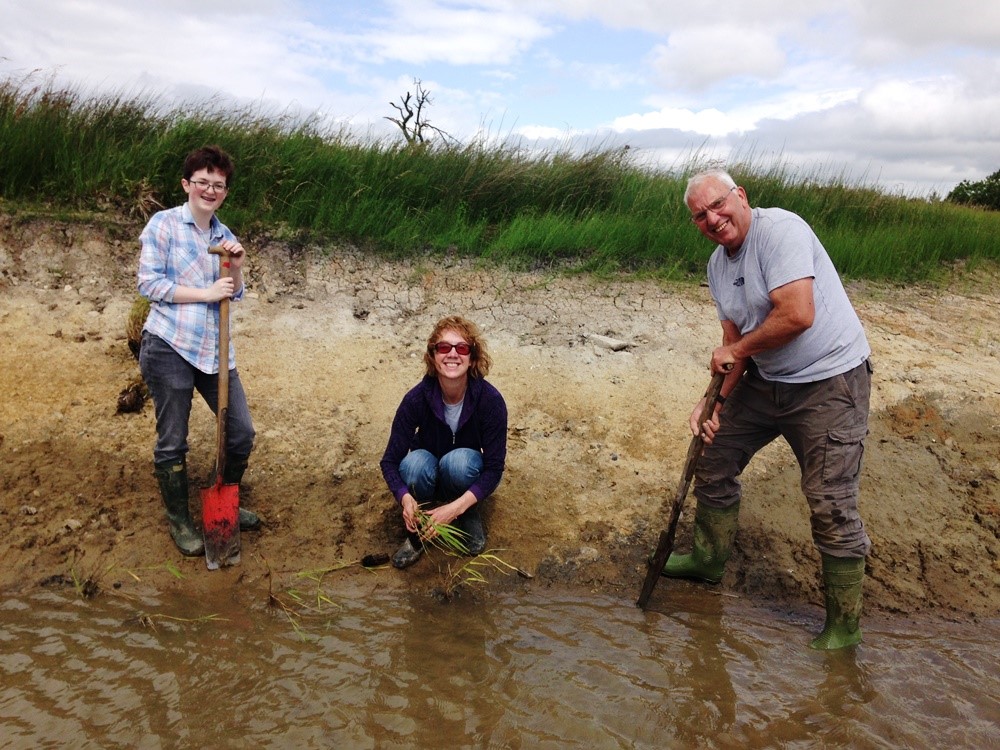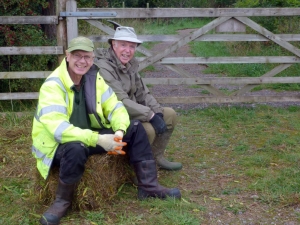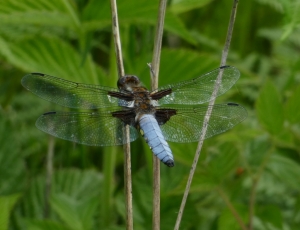Blog Archive (31) Posts Made in May 2018
Ringing and Net Rides
Thursday, May 31st 2018
Members of the Foxglove Management Group met this morning to set out plans for future management of the reserve. Clear priorities for this coming winter will be work on the Wetland and Heathland, and Willow coppicing in the final compartment of five under the 10-year Higher Level Stewardship agreement with Natural England. This will form the framework for a first draft by the Reserve Managers of a new Management Plan for the reserve covering the next 3-5 years.
.jpg)
Once the meeting was finished, Management Group members headed off to do checks on nest boxes in local woods and over to Warcop. There was still time to check a couple of nest boxes at Foxglove for Jackdaw chicks. While one was empty, the second had four chicks in which have now been ringed.
.jpg)
Other volunteers were in today as well as those on the Management Group, and, with the weather being hotter than yesterday, most enjoyed the shade from the trees in the net rides as they trimmed back any growth that might catch in the nets during upcoming ringing days. There was also time for a quick bit of plant identification as we scoured the Heathland for signs of Cross-leaved Heath (Erica tetralix). As the native heather that enjoys more moist ground conditions, it was found in a lower lying dip and we hope it spreads to other damper patches within the Heathland.
Pond Dipping and Tit Chick ID
Wednesday, May 30th 2018
Damp weather didn't deter the intrepid band of pond dippers this morning. After a short briefing to make sure that everyone stayed dry by not falling in the water, the heavens opened and there was a heavy downpour for the first 10 minutes of the activity.
.jpg)
Despite this, all nineteen taking part were able to catch examples of Foxglove pond life. By far the most common were the tadpoles, but there were also many Sticklebacks, several Pond Snails, snail eggs, Whirligig Beetles, a Pond Skater, Damselfly and Stonefly larva and a Water Boatman. This was a chance for Ian, one of our newer volunteers to get involved in our events and he spent two hours helping with species identification.
.jpg)
Meanwhile Ian joined Sophie on a trip to check up on the nest boxes at Marne Barracks.
The visit proved well worth it, and provided a masterclass in Tit chick identification; finding and ringing many Blue Tit (Left), Coal Tit (Centre), and Great Tit (Right) chicks.



This was an excellent opportunity for any novice Bird Ringer as you were quickly able to start memorising the differences between the chicks. The most noticeable difference between the Blue Tit and Coal Tit being the shape of the patch of lighter feathers on the back of the head; whereas the Great Tit chicks have white outer tail feathers and a mardy look about them (due to the drooping corners of their beaks when compared to other Tit chicks).
Damsels and Damselflies
Tuesday, May 29th 2018
I won't say too much about today aside from that the volunteers have been hard at work strimming, mowing, and maintaining the reserve, and that the weather has been no where near as good as it was over the Bank Holiday.
It was interesting to see the sheer volume of Willow seed fluff covering much of the reserve today, I even panicked when I saw the Heath as I thought we had had yet more snow!

The Water Voles have clearly been sheltering from the turning weather, using the Mink raft on the Scrapes. It's great to hear and see evidence of the Water Voles on the reserve again after a period of little activity!

The weather was much more favourable yesterday when we were joined by a small group of big kids wanting to go Pond Dipping.

Much of the same was found with the addition of the emerging damselfly larvae, one of which managed to make it's way onto Melissa's hand before escaping it's exuvia.

Time to Stop and Stare
Monday, May 28th 2018
The name of the insect, read moth, in the Buttercup has arrived. It is Micropterix calthella and it feeds on pollen of a variety of flowers including Buttercups and Marsh Marigold. I have also photographed it in Cuckoo Flower and Welsh Poppy. Not too clearly shown, but if you look carefully you can see that they have hairy heads. Nature is just fantastic! Next sunny day a better close up to really see the hairy heads! It has been recorded on the species list but not since June 2010, so it will be good to update the recording.

I also took time to stop and stare yesterday, not at vistas but at little things that caught my eye. Cercopis vulnerata, the Black and Red Froghopper was hopping about in the nettles.

Hawthorn leaves should be green so when a red one was noted I was curious. Back to the Internet and it appears to be Hawthorn Redfold Gall, but more research is required.

We are also looking into this gall or rust on the back of Common Dog Violet leaves, which could possibly be Cercospora violae, But again a bit more reading is going to be needed.

After spotting a Yellow Flag Iris bud just showing yellow one day it was astounding to see it fully opened the next.

Water Avens flower along Risedale Beck and along many path edges. There are usually mutations growing amongst some of them.

Much of the Yellow Rattle on the middle moor is still quite small but there are some in flower.

We heard today that we have been awarded a Certificate of Excellence for 2018 in recognition for 'consistently great reviews', from Tripadvisor.
This is a credit to everyone who looks after Foxglove, from admin work to habitat management, species recording and bird ringing. Visitors comment positively about the warm welcome they receive and how amazing the hidden gem of Foxglove is. Thank you to everyone!
Work in the Sunshine
Sunday, May 27th 2018
The bird ringers divided into two teams, one checking nest boxes on the training area, whilst the other group checked Foxglove. Although busy both groups managed a little time to stop and stare. This is a view across the training area.
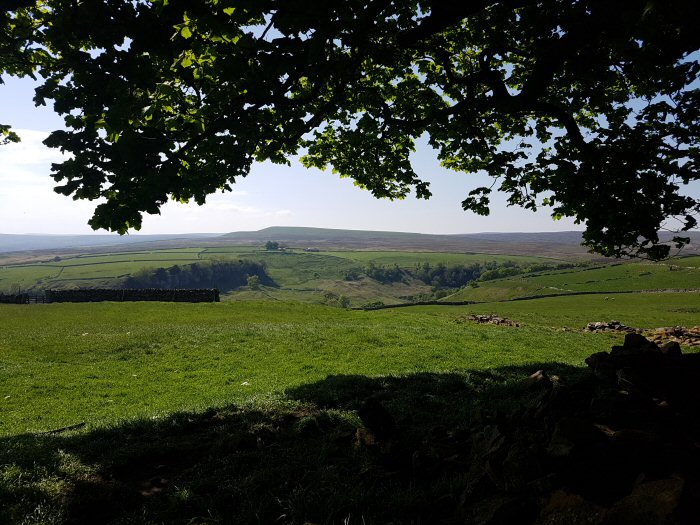
This beautiful wood has many old trees and there are several boxes of chicks.

Colours on the far side of the lake have changed from black and brown to greens, with the white of Hawthorn showing through.

Back to the chicks. Some were too tiny to ring and these will be visited again at a later date.
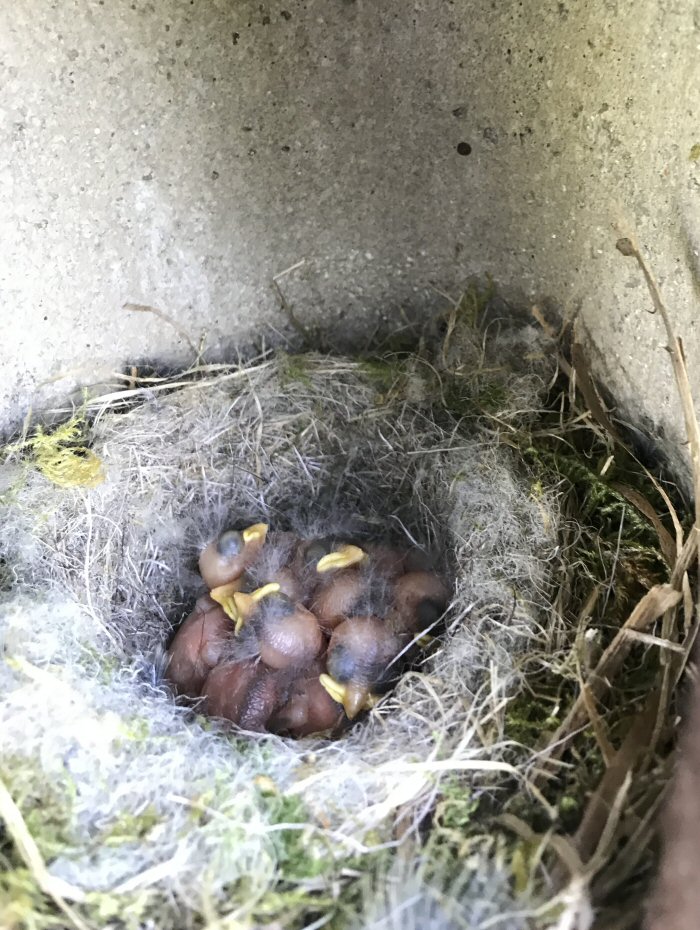
These Coal Tits identified by the white mark on the back of their heads will not be long before they fledge.

Some of the broods are large with eleven chicks. One set of Great Tits were reported to be, for want of a better word, fat!
Kestrels were also ringed and this group shows the different sizes of young, as the female starts to incubate as soon as she lays her first egg.
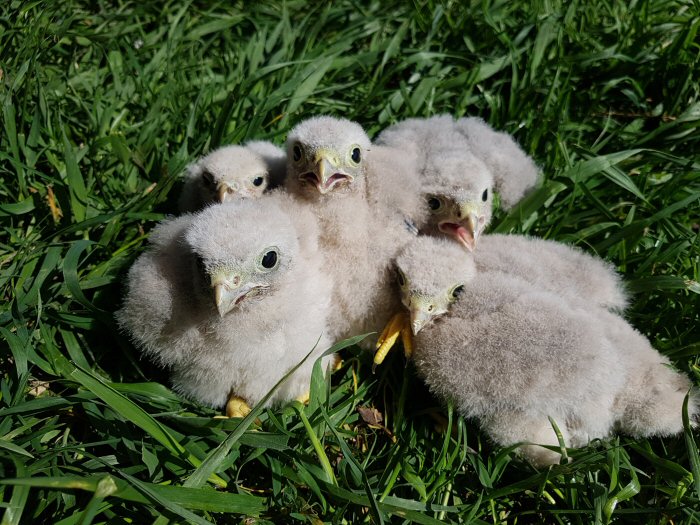
All the bird ringers had a long day carrying out this essential work. Some of the birds ringed today will soon make their appearance in the ringing room. A huge thank you to all involved and for the photographs.
At Foxglove everthing seems to flowering, flying and growing! Being in the right place at the right time can sometimes give you a moment to remember. Plovers Pool was a watering hole for a flock of House Martins. Never easy to photograph, honestly the splodges are House Martins! Once they had had their drink they disappeared!

Whilst watching their aerial acrobatics I noticed something else. Dragging my eyes away from the birds I realised that I was watching a Broad Bodied Chaser, hunting across the water. A perch by the side of the pool gave me great views and the opportunity to take a photograph that was in focus. Usually they move far too quickly for any sort of image to be taken. This species enjoys more open ponds with little vegetation, Plovers Pool is ideal for them.


There are still Early Purple Orchids in flower and the Northern Marsh are joining them.

And finally - how may insects can you get on a single buttercup flower?

So Much!
Saturday, May 26th 2018
Everything is flowering and there is just so much to see. Hawthorn trees are covered in blossom, even the old one on the moor has flowers.

I thought this line of Hawthorn flowers a little different to the usual mass of flowers.

Finally the weather was calm enough for moth trap to be set away from the Field Centre and there were some amazing moths. Green Silverlines was beautiful and has only been recorded twice before, once in June 2010 and then again in June 2015.

Ruby Tiger was another moth not often seen, recorded in June 2010, 2015 and last year. You can see the black markings on its abdomen.
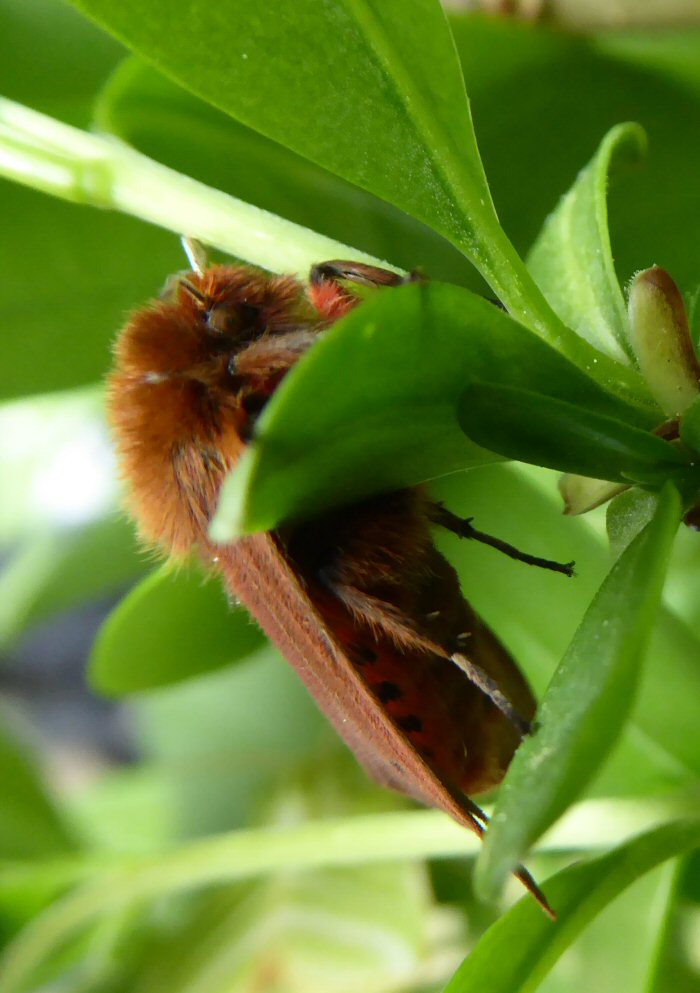
On Tuesday volunteers saw moths flying around the heath, so the moth team headed there on Wednesday. Yes the moths were there but their diving down into the Heather after a flight meant photographs were impossible. Then one was spotted almost caught in a spider's web, so it was rescued and we could photograph it. Our records show that it was last seen in 2005.

It sounds so good that we can identify Spindle Ermine Moth caterpillars, but we have to admit that the only reason we know this, is that the caterpillars are on Spindle!
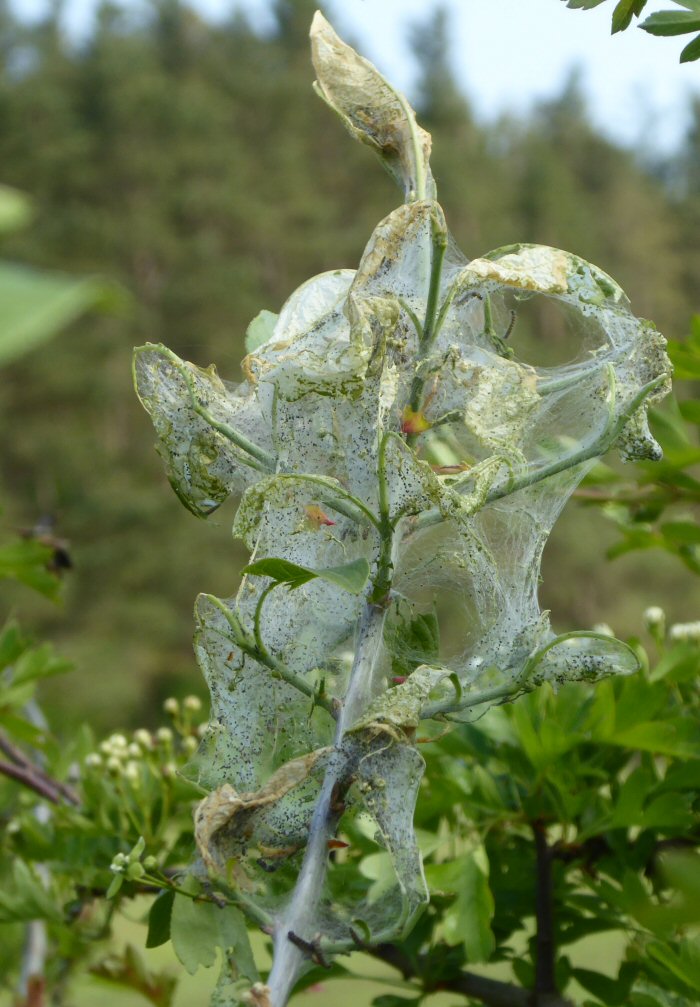
These tiny insects were feeding on Cuckoo Flower, possibly micro moths, but after our last attempt at micro moth ID in 'the wild', that turned out to be a leaf hopper, I will leave these as insects!

Over the years many species of flower have increased their range. Bluebells can now be seen in many areas of the reserve.
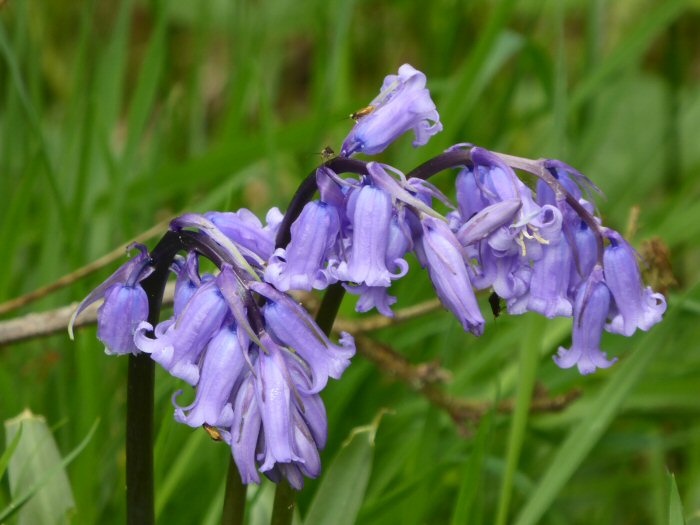
Lousewort was originally found on the wetland, then one small plant was seen on the middle moor. Now there are several areas of this semi parasitic plant to be found across our hay meadow.

Richmond Beavers and Rickety Rafts
Friday, May 25th 2018
Richmond Beavers paid a visit to Foxglove last night and caught a plethora of pond life, including tadpoles, sticklebacks and water boatman.

Today Colin has been making his way around all of the bird feeders and vole platforms, before lending a hand and his expertise in making mink rafts.


A mink raft serves to encourage American mink (Neovison vison) to leave evidence of their presence.
The American mink was first introduced to our shores for fur-farming, with the first wild, non-native populations establishing through multiple escapes many decades before the well publicised mass releases by animal rights activists during the 1990s.
The voracious mink continue to be a threat to native Water Vole and ground nesting bird populations, which is why we carefully monitor their populations.
Net Rides, Insects and Nest Boxes
Thursday, May 24th 2018
Work on the Heathland and the net rides continued today, with cutting of the grass within each net ride being completed for nearly all of the rides. While one group of volunteers did this part of the job, another was busy working on the garden at the Field Centre and, when that was finished, moved on to trim back any growth on the trees surrounding the rides to make sure that there will be plenty of space for the nets.

.jpg)
Work then continued on removal of Birch, Gorse, Hawthorn and Willow from the Heathland using the tree poppers to pull them up. Given how cold it got yesterday evening when we had a visit from Brownies and Rainbows from Leyburn, it was good to work in the warm sunshine today.

While work will continue to stop the Heathland being colonised by those tree species being removed, it is good to see the area's diversity. The small pools around the three Heathland compartments were attracting invertebrates in the warm weather and Ian was able to get this picture of a Four-spotted Chaser using one of the old stems of Reedmace as a vantage point.

Elsewhere, while there is still some work to do on strimming back the Soft Rush on the Wetland, Lark and Taurus have returned there to tackle the emerging grasses on the bunds and around the sides of the ponds. This will be a short term measure so that we can monitor the impact of their grazing and the effect of their walking around on other vegetation.

Work today is not yet finished. Ian has set off to join a group checking nest boxes around the training area. Talking to a visitor yesterday, I mentioned that we would be getting Beavers at Foxglove this evening, and he briefly got very excited, imagining large mammals felling trees to dam the watercourses. Sadly, I had to explain that these will actually be the youngest members of the Scout movement. Judging by how much the Brownies and Rainbows enjoyed their minibeast hunt and pond dipping yesterday, I think they will probably be as enthusiastic and excited.
Minibeast Madness
Wednesday, May 23rd 2018
Wavell Junior School visited us again today to learn about land use, habitats, minibeasts and pond creatures.
A big thank you to Jenny and Elizabeth who helped out today, and to Ian (Humpleby) for leading the Risedale School pupils on their task to tidy up around the reserve.
Today I (Reserve Manager Ian) was leading the minibeast hunt at the Outdoor Classroom and Moorland where we busied ourselves with turning over logs, looking under leaves and shaking trees.

One of our most popular discoveries was this magnificent Sexton Beetle (Nicrophorus vespillo).


One of our most easily recognised and widespread beetle; the Sexton, or Burying Beetle is an undertaker of the animal kingdom. Male and female Sexton beetles will pair up and defend dead animals before stripping the carcass of hair or feathers, digging underneath it and burying it.
The female lays her eggs on the soil above the corpse, which is used as food by the larvae once they have hatched. Unlike most beetles, both the male and female Sexton beetle will care for the young after they have hatched.

All three groups also had a chance to catch things with the sweep nets and managed to find a number of frogs hunkered down in the long grass.

Wetland and Water Voles
Tuesday, May 22nd 2018
There were two priorities for work with the volunteers at Foxglove today. Having cut back the soft rush on the wetland last month, it has regrown rapidly so needed strimming again along the edges of the ponds, particularly the ones nearest to the hide. This has also given us a chance to monitor how well wildlife has been doing here and it was great to see three Water Voles while doing this work.
.jpg)
Apart from keeping an eye out for Water Voles and nesting birds, the wetland flora is starting to develop and the Adder's Tongue Fern is now showing in several places. These have been carefully avoided within the strimming regime as they also coincide with the first leaves of Common Spotted Orchids.

The work of the volunteers is an important part of managing the reserve. We are in the process of updating the leaflets about Foxglove and the opportunities for volunteering here, so we took advantage of breaks in work to get photos of the volunteers to feature in the new leaflets. Removal of an old section of boardwalk also provided a photo opportunity.

Work wasn't just confined to the wetland and another group have been busy on the heath. Although the volunteers have worked their way across these areas removing growth of invading trees several times in the last few months, with many now having leaves on it shows how much is still left. Willow, Birch, Hawthorn and Gorse saplings have all been pulled up with the aid of the tree poppers. Again, the area was carefully checked for nesting birds with a solitary Common Frog being found.

Thirteen people have been out volunteering today, and they have made significant impacts on both habitats. Their work is very much appreciated.
South Durham University of the Third Age
Monday, May 21st 2018
To prove that there is always something new to find at Foxglove, today we had a return visit from the South Durham branch of the University of the Third Age (U3A), who had last visited 2 years ago. After tea and coffee in the Field Centre and a short talk on the management and development of the reserve, we headed off out to the Middle Moor hay meadow and the moorland before moving into the shade of the Larch plantation and on to the Lake Head
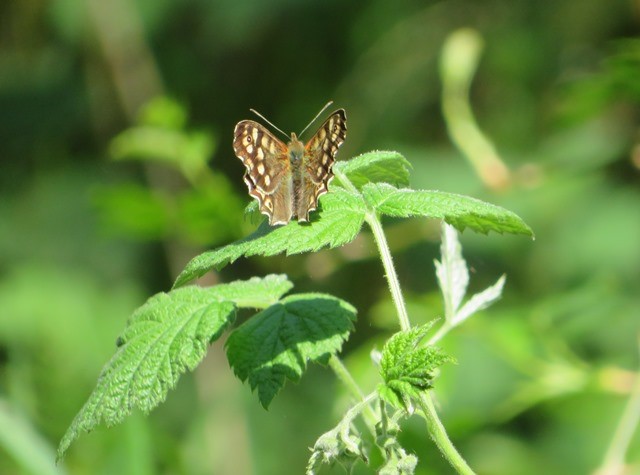
Before we started some of the U3A members were trying to identify a butterfly that they had seen at Roseberry Topping last week. Going round we saw both male and female Orange Tips, male Brimstones and Speckled Wood in the glades among the trees. This helped eliminate some of the suggestions and we ended up with a probable identification of a Small Tortoiseshell.
The group really enjoyed themselves and have even suggested a further visit, although this time in autumn or winter when they may be able to see more with less foliage on the trees.
Two volunteers were in today, and we welcome Ian as it was his first day today. Work continued on cutting the net rides with a further ten being cut to keep the grass growth down.
Out near Plover's Pool, Lark and Taurus continue to do the same, but Lark did take several minutes this morning to use one of the tree shelters to scratch a number of itches starting with his nose and ending with leaning his hind quarters into one post of the shelter and moving from side to side. I don't think that's what it was put there for, but it seemed to do the trick!
Where to Start?
Sunday, May 20th 2018
The sun and warmth are bringing everything out and it is a joy to see the reserve turning colourful after what, to me, has been a long winter of white, grey, black and wet. A flash of red or blue are the damselfies flitting amongst the vegetation and over the ponds.
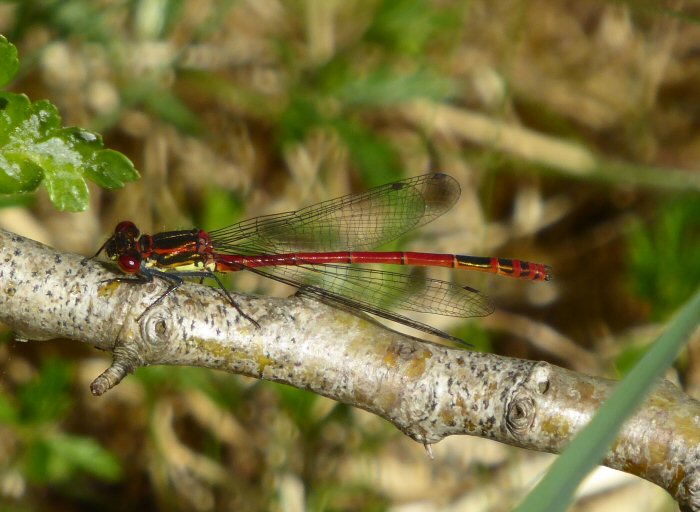
Blue damselflies are not the easiest to identify so I will play safe and say this is one of the blue damsels!

Speckled Wood butterflies appreciate the sunny glades that can be found around the reserve and enjoy the warmth of the sun.

Mainly flying at night most moths remain unseen. Lights on the Field Centre can attract them to the walls. I transferred this White Ermine from there to the Privet hedge for a photograph.

The hive bees kept us on our toes yesterday as most of them left the hive to fly around the back garden, probably to cool down. We were a little concerned that they were going to swarm but we could not find a queen cell in the hive, a trigger for swarming. So we waited and listened to their loud buzzing until they decided to return. There was then a 'bee-jam' at the entrance as they waited to reach the opening to their hive.

Whilst some flowers are just flowering others have set seed like this Coltsfoot, to be found in the rocks in the stream leading from the weir, at the lake.

This Welsh Poppy was not open on Thursday but was on Saturday.
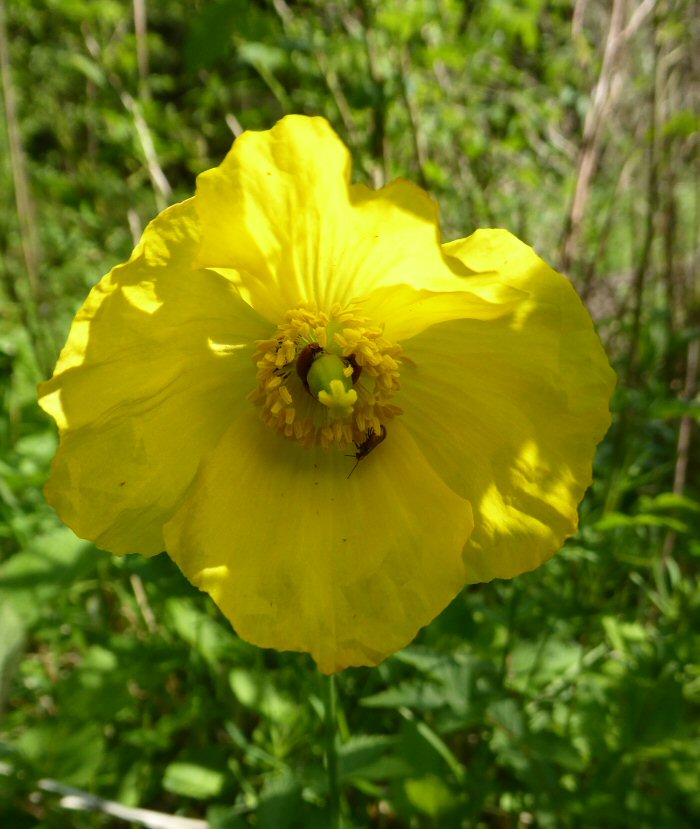
There are Bluebells across the reserve, continuing to grow in more areas than ever. There is even one on the heath! i must admit that the best display is around the Stone Circle and that was captured by Adam.
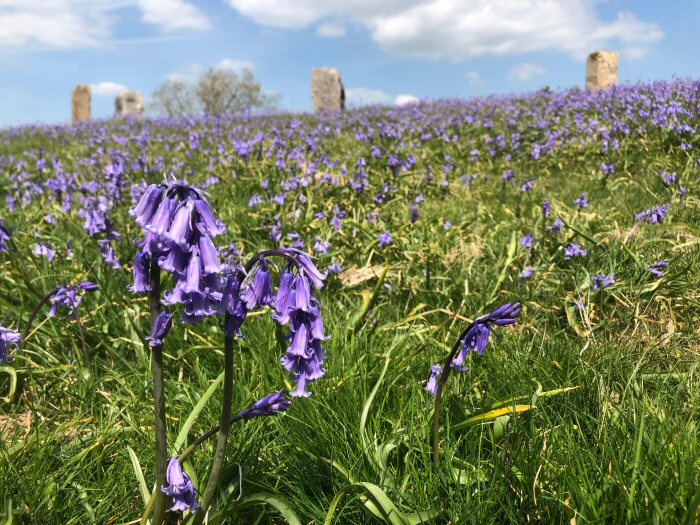
Lark and Taurus are enjoying the new growth of grass around Plover's Pool.

Working Together
Saturday, May 19th 2018
Careful organisation and everyone working together we were able to hold our Birdsong Breakfast and complete CES 2 today. Huge thanks to everyone involved, your help and support is really appreciated.
Starting with the BSB, two groups set off around the reserve to listen to the Dawn Chorus. Cuckoo, Garden Warbler, Blackbird, Chiffchaff and Song Thrush were amongst some heard. One group stopped at the pond dipping platform to listen for Willow Warblers.

After walking around Foxglove they all set off to head to the training area to see what was about. Mark took this fantastic photograph of a Curlew in flight.

People were able to see two Curlew chicks ringed and also see at first hand how difficult it can be to find them, as once released into the vegetation they almost totally disappeared from sight.

The convoy continued to cross the training area before heading to Wathgill for breakfast. Thanks to the chefs for yet another excellent spread. Everybody thoroughly enjoyed this event.

Meanwhile back at Foxglove the nets were raised. It was not a busy day as is often the case with CES 2, as most of the females are still sitting on nests. We did catch two juvenile Robins. A beautiful Sedge Warbler was also processed,
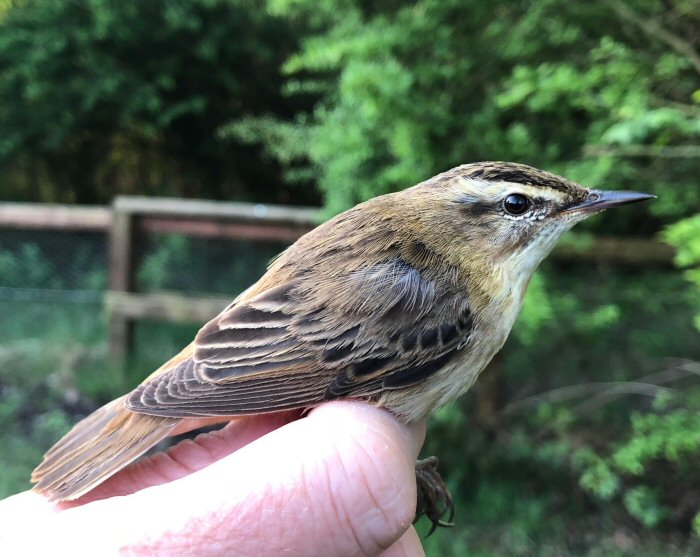
and a female Blackcap.
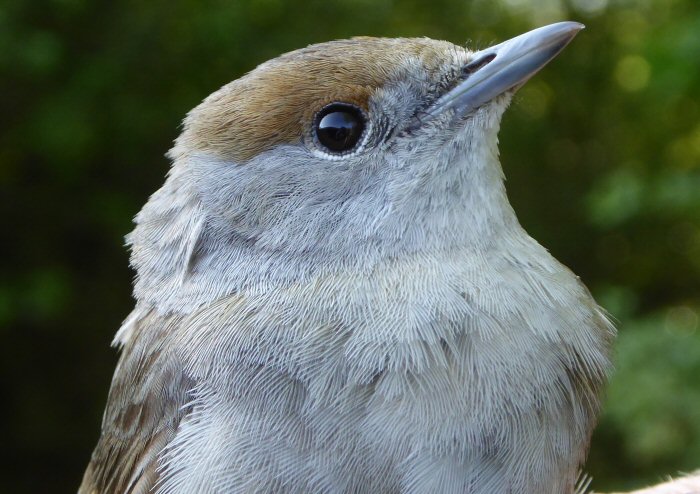
Birds and Birders
Friday, May 18th 2018
Picking up from Wednesday's blog, we were waiting for the group of Guides from Leyburn to visit the reserve that evening. Ten Guides and two helpers spent two hours pond-dipping and looking at how bird ringing is carried out in the Field Centre. All were very pleased with their visit, and there was an impressive number of Sticklebacks caught, as well as tadpoles, Whirligig Beetles and a Water Scorpion.
.jpg)
Today we have had visitors from slightly further afield with 26 members of the South Leicester Birdwatchers group calling in as part of their weekend trip to Yorkshire and the North East. They spent 5 hours and managed to see a wide range of birds, butterflies and flowers while they were here. These included Swallows, Lapwing, Sand Martin, and they were all taken with the Little Grebe and their two chicks on the lake. They have now headed off to stay overnight in Northumberland before sailing over to the Farne Islands tomorrow morning and then to the RSPB's Saltholme reserve on their return leg.
.jpg)
They started with a short talk on the history of Foxglove, but it's fair to say that their attention did wander every time any birds arrived on the feeders outside the Field Centre.
Colin has again been in filling the feeders and the hoppers so that they are ready for the weekend which will include both ringing and the Bird Song Breakfast event. This will mean an early start for all involved.
Whereas Ian and Tony headed out in the late afternoon in search of an ever elusive Kestrel in nearby Stonecutters' Wood. She was not at home, leaving her clutch of five eggs for us to find in the nest box.

These birds really do have a tremendous sense of hearing, picking up the slightest rustle of leaves as you brush past in the undergrowth; one snap of a twig and you've had it!
Moths, Flowers and Beasties!
Thursday, May 17th 2018
It was changing of the moth guard yesterday morning. We had several moths that were the first of the season. Brimstone Moth, Brown Silverline, Grey Birch and Spruce Carpet to name a few, with no photos as they all flew away, as soon as they were released from their pots! We did manage to photograph a Pale Tussock Moth. Being very scientific this moth is lovely and furry and when it walks off your finger it is like velcro peeling off, very gently.
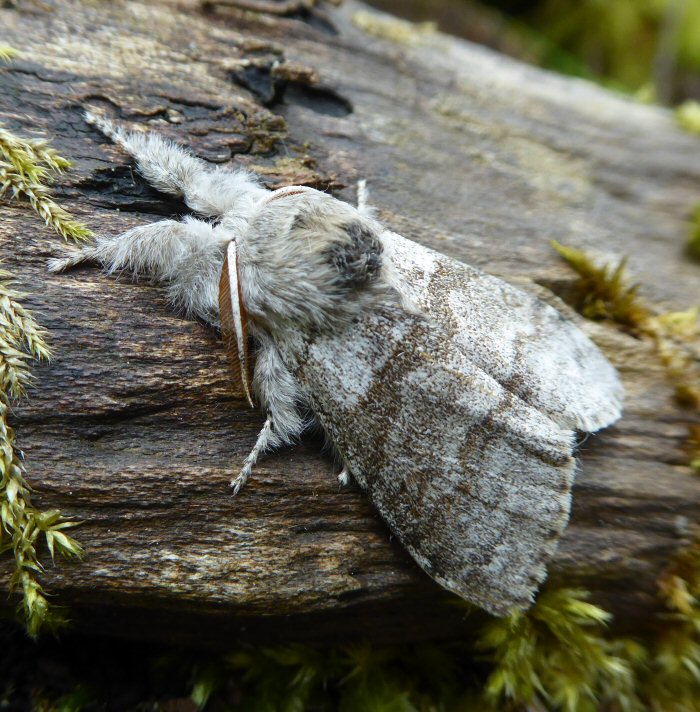
Scalloped Hazel half co-operated but it does have a bright red leaf of Herb Robert almost in the way. When we moved the offending leaf, the moth did not approve and disappeared under a log!

There were 82 moths of 27 species, most of which were found on the sheet, around the trap and on the Field Centre wall. Thanks to Pauline and Jenny for help with ID.
The flower walk this morning followed Risedale Beck, past the heath, along Dog Daisy Avenue, through the Scrapes and back to the Field Centre via the Lake. Bluebells, Primroses, Wood Sorrel, Greater Stitchwort, Crosswort and Wild Garlic were all seen. Continued examination of Cuckoo Flowers revealed an Orange Tip Butterfly egg on a dew covered flower stem.

Marsh Valerian is doing really well. Stamens and stigmas are produced on separate flowers and I was amazed to see that two flowers that I photographed, next to each other, that one was male the other female. You can see the pollen grains covering the stamens.

The female flower has the stigma inside the tiny petals.

Later this afternoon a single flower of Mealy Primrose was noted.

For several years I have been disappointed not to find a male Juniper tree, often getting excited, only to find that it was a new leaf. However not only did we find one, it was releasing its white pollen.

Further examination of the tree revealed lots of tiny spiders and some greenfly or aphids to give them their correct name. Back to the internet to find that these aphids were Juniper Aphids and a new species for the species list.

From tiny to almost large, these owlets were ringed last night. You can see the difference in size, from the oldest to the youngest.

Many thanks to the volunteers who are out checking nest boxes, ID'ing species and repairing steps, paths and bridges. Your help is always appreciated.
Of Moths, Mini-beasts and Mapping
Wednesday, May 16th 2018
After what seems like ages since there was a large collection of moths found in the moth trap, the number of moths found this morning suggested that the decision to put out the trap last night was the right one. Despite the overnight rain, there were that many around the trap to be caught that it took nearly 30 minutes before the contents of the trap could be examined. There will be more detail on this in tomorrow's blog.

Meanwhile, the reserve was playing host to groups from Wavell Junior School and Risedale School. Pond dipping proved very popular with the Wavell School group, as one of their three activities during the day. The afternoon session was spent around the Outdoor Classroom looking for bugs and creepy crawlies as part of their hunt for mini-beasts.

Clearly, they all enjoyed themselves and we will be getting another visit from Wavell Junior School next Wednesday. Meanwhile, the small group from Risedale School were having a walk around to introduce them to the habitats on the reserve. We are looking at having them here every Wednesday to do practical work to help manage the reserve, as well as doing some of the activities.

Thanks must go to some of the Wavell Junior School staff who helped tidy up the Field Centre's Activity Room to make it ready for the next group to move in.
This was the Defence Infrastructure Organisation's (DIO) Business Intelligence Team who used the room to work on how they deliver digital mapping for the Army. However, before they got down to the detail, they played a sophisticated version of 'hide and seek' with an exercise in geo-caching, where objects were put out and their locations tagged. These were then found using satellite technology to find the co-ordinates for the locations.
With all this going on, the more eagle-eyed had spotted that one of the finger posts had a sign that was drooping, so Ian spent a few minutes re-attaching it so that it is now back pointing horizontally.
The day is not yet finished. While volunteers continue to go out to survey nest boxes, the last group of the day to visit Foxglove this evening will be from Leyburn Brownies.
Nest Box checks at High Spring Wood
Tuesday, May 15th 2018
I started my day with the Volunteers where we continued cutting back rushes on the Hay Meadow and near Moorland, taking care to avoid the occasional Cuckooflower, Speedwell and other flowering or soon to be flowering plants.


Leaving the team around lunch time I headed over to meet Lesley at High Spring Wood.
Plenty to see as always, with many Garden Bumblebees, Common Carder Bees, Drone flies, as well as Orange-tip and Green-veined White Butterflies. We were also greeted by a sea of Cotton-grass, which is in fact a sedge and not a grass at all!

Arriving at High Spring Wood as someone who has never seen it in all its glory before was quite a shock. I have never seen such an impressive Bluebell Woodland!

Once we found the first box we were on to a winner with the first two boxes being occupied by Pied Flycatchers and each with a clutch of eggs.


All in all, over 12 nest boxes to come back to at High Spring Wood and over 30 Pied Flycatcher eggs in total, as well as a few Great Tits and Blue Tits.

Juncus removal
Monday, May 14th 2018
I've been focusing on removing Juncus at risk of outcompeting the wildflowers of the Moorland and Hay Meadow that are due imminently.
A swathe of vegetation has been cut from the Moorland which according to Google is over 1 km squared; a similar sized patch will need removing tomorrow from this area in order to finish the job.

Similarly, the triangular portion of the Hay Meadow bounded by the path and the wire fence has also been cut today, an area of around 650 meters squared.
This area continues to pose a challenge due to the uneven, boggy ground meaning that the entire thing has to be strimmed, all the while avoiding the emergent wildflowers just starting to poke their heads up above the sward.

The final area I managed to get finished today, alongside the path was another 400 meters squared, totaling over 2km squared of ground covered so far.

The last thing on my list for the day was to stake up a fallen Larch on my way back to the Field Centre.

Spring
Sunday, May 13th 2018
There is no story or theme to the blog unless it can all be encompassed as Spring!
Spring is well on its way and this is reflected in the many different greens on the trees, interspersed with the white blossom of Bird Cherry and the new ruby coloured leaves of Beech.
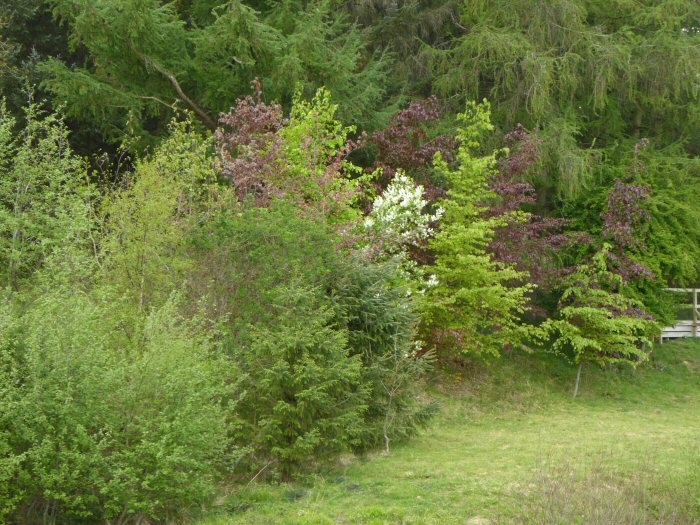
The bridge rails are usually full of a variety of bugs and beasties, but so far this spring few have been spotted. It may be that I am just very impatient! Careful scrutiny did reveal a large female and the much smaller male Alder Fly.

Further on a different stonefly to the normal ones seen was also spotted. It was larger and had patterend wings.
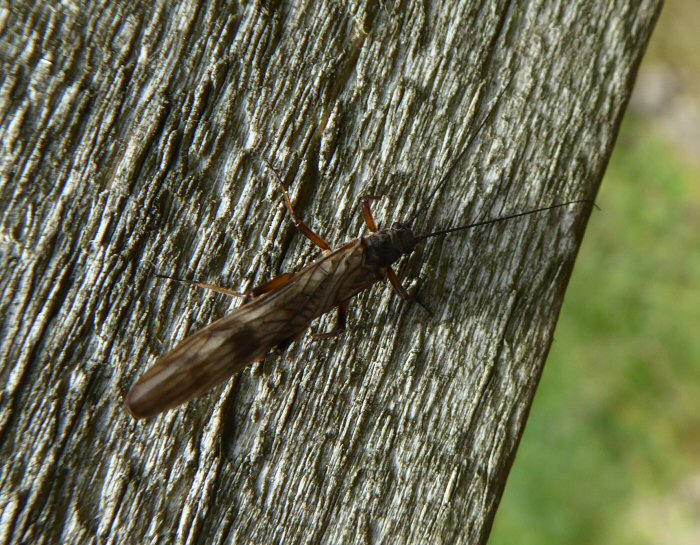
A Dryad's Saddle fungus has regrown on a tree where it was found two years ago.

Male Orange Tip butterflies can be seen flitting through the new spring vegetation, rarely stopping for a photograph. Whilst busy examining the orchard trees I realised that at my feet was a female Orange Tip on a Cuckoo flower and not only did she remain there I could see that she had an orange coloured egg on the stem of the plant.

Most of the female Mallards are sitting on their nests, whilst the males take life easy. Preening is very important to keep plumage in prisitine condition.

Feeding is needed to keep up their strength when all those pesky ducklings invade the lake!

To finish the blog some dates for your diary. If you wish to visit the flowers of Foxglove Covert there is a guided walk on Thursday 17th May starting at 10am. For an earlier start, 5am, then it is not too late to book onto the Birdsong Breakfast on Saturday 19th May. And finally the Foxglove Coffee Morning will be held in Richmond Town Hall on Thursday 14th June. There are more details on the events page.
Well almost to finish the blog. Concentrating on the pony heading towards me I took the photograph. Downloaded I saw that I had a right angled Exmoor Pony!

RSPB Newcastle Group Visit
Saturday, May 12th 2018
Today we have had twenty-seven members of the RSPB's Newcastle group visiting the Reserve for five hours. Having stopped at Scotch Corner on the way down, they were raring to go when they got here. After a welcome to the Reserve to describe the habitats here, they set off in various directions to explore Foxglove.

Bumping in to some of the group in the Wetland Hide, we were able to see how many species they had been able to find. The Wetland was very quiet, but they were able to see much more in the woodlands around the Lake as well as watch the Little Grebe, Mallard and Tufted Duck on the Lake.

The gentleman here had been able to get a good picture of one of the Roe Bucks that are in the area around the Cascading Ponds. Had he been up by the entrance gate he would have seen a pair of Roe Bucks deciding which one was the more dominant. This is unusual as they tend to be more secretive during the summer, so finding them on the access road was a bit of a surprise.
.jpg)
On their return to the Field Centre, we had many compliments about both the facilities within the building and about how well laid out the Reserve is.

Some also spent time looking for plants and insects and were able to see the increasing number of Early Purple Orchids on the bank above Risedale Beck and watch both male and female Orange Tip butterflies moving between the stands ofd Lady's Smock. The group had a wonderful day and left with promises that many would return again in the not too distant future.
Le Cateau Community Primary School Visit
Friday, May 11th 2018
Today was the second day for staff and pupils from Le Cateau Community Primary School to visit Foxglove Covert. 6 staff and 28 pupils carried on with the activities that other pupils had worked on yesterday. Despite the fact that it wasn't as sunny today, they all threw themselves into the activities with a lot of energy and enthusiasm.

As always, pond dipping proved very popular and each group managed to find a wide range of fish, tadpoles, pond skaters and snails to show just how rich the wildlife is in the ponds on the Scrapes. Colin was in today filling feeders and had clearly already been active here as he'd put apples on the Water Vole rafts before the activities started at 10.15.

Away from the Scrapes, groups spent time looking for Spring flowers, listened for bird song and for birds and insects flying around the Reserve. The habitats of Foxglove were the theme of the third group activity. While most of this was within the deciduaous and conifer woodlands in Risedale Beck, the Heathland and Willow Carr were also investigated with plant identication, the effects of light and shade, and woodland food chains all being discussed.

Feedback from yesterday's group was that they had all gone back to school 'buzing'. Judging by the way that the pupils worked today, I expect that the feedback will be much the same.
Plenty of activity
Thursday, May 10th 2018
Twenty-seven staff and pupils from Le Cateau Community Primary School visited Foxglove today on the first of their two days at the Reserve. Pond dipping proved very popular with them and they also took their lessons from the classroom into the Reserve to look for signs of Spring. This group were busy looking at several habitats including a walk along Risedale Beck to look at the flowers on the sunlit south-facing bank and contrasting this with the darker areas underneath the stands of conifers.

Also in Risedale Beck, now that the flow of water has diminished with the recent warm spell of weather, the inlets into the two small ponds have been exposed so that they were no longer taking water from the beck and were starting to dry out. The group of volunteers in today have been rebuilding both dams to raise the water level back up to feed through the pipes.


While this was taking place, another group of volunteers have been continuing with nest box checks so that we are getting a better picture of how many of the boxes are now being used. Thanks to all who have helped today and have accomplished so much.
Species Volunteering
Wednesday, May 9th 2018
There were such arrangements for the moth trap last night. It was going to be placed away from the Field Centre, but WEATHER overtook the plans as it rained so the trap was left on the back veranda. The temperature also dropped so the catch was not a large one, 21 moths of eight species. We did try to photograph some of them but they were 'not playing' and flew off.
One tiny moth did co-operate. We think it is Least Black Arches but this will have to be confirmed.

Flowers are continuing to burst their buds and Bitter Vetchling was added to the list,

along with Ramsons or Wild Garlic.

Red Campion always flowers at the head of the Scrapes first. The other major area, along Risedale Beck, does not show pink for another couple of weeks. We always check to see of any if the male flowers have been affected by the smut, Microbotryum lychnidis-dioicae. There was one flower showing the typical brown of the smut.
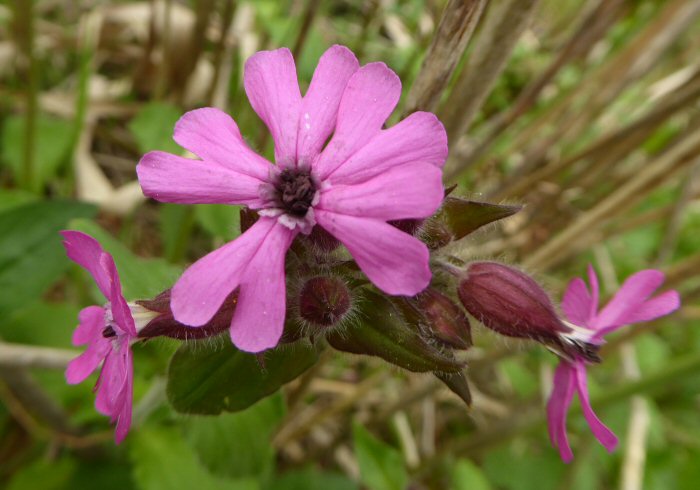
Whilst photographing the Early Purple Orchids a Green Veined White sat on a Bluebell.

The information coming back from checking the large nest boxes is very positive. Some of the small boxes at Foxglove were checked today.

Volunteers were busy with a variety of species related activities including moth identification, flower hunting and checking nest boxes. Thank you very much for all your hard work. It was a very good day!
Coppice clean up
Tuesday, May 8th 2018
Beautiful weather on the Reserve again today, although not the best weather for wearing the extra padding and protection provided by chainsaw trousers!
We made a start on tidying up the coppice block between the Scrapes and Lake today, managing to get through two huge piles of logs in need of moving.
.jpg)
John and Eddie moved over 20 full wheelbarrow loads up to the quad bike trailer at the lay-by, while the rest of us processed the timber and carried out essential grass cutting works across the Reserve.
.jpg)
It was decided that we would stop for a break before lunch in order to test out the new canoe; (un)fortunately the vessel performed admirably with almost all crew members remaining relatively dry.
.jpg)
.jpg)
.jpg)
Meanwhile Colin set about filling the bird feeders, all of which are now depleting at a much reduced rate, before moving on to the edging on the front lawn of the Field Centre.
.jpg)
Getting Involved
Monday, May 7th 2018
There are many ways to get involved with Foxglove Covert. Volunteering is great fun and can be a fantastic way to meet new like minded people. The main volunteer day for practical tasks is Tuesday. In the winter time the group usually work together on major habitat management jobs such as coppicing trees and scrub clearance. This is physical outdoor work and a good way to get fresh air and exercise!
.jpg)
No experience is required, just a willingness to learn and have fun! There is never any pressure and volunteers work at their own pace. In the summer, jobs vary and are more to do with the day to day running and maintenance of the visitor facilities. Tuesday tasks can include painting signs, improving footpaths and pruning back branches alonside pathways. Mowing and strimming also feature during the summer month job list.


At Foxglove we monitor around 100 large nest boxes and hundreds of small ones. These have to be repaired and replaced before the breeding season. This brings with it opportunities to visit other MOD conservation sites. As you will have seen on recent blog posts, there are chances later in the year to return to these nests to ring the resident birds.
The Swaledale bird ringing team meet on most weekends to monitor the bird population. This is usually done through mist netting under BTO guidelines. Volunteers spend many hours ringing birds and all data collated is sent to the BTO for important research.

All wildlife is surveyed and volunteers help with recording flowers, plants, trees, invertebrates and mammals too. If you have a relevant skill or interest then please get in touch. If you would like to learn more about a particular species then we would love to hear from you too.

Nature is offered a helping hand at Foxglove and volunteers help with filling bird feeders, checking the Exmoor ponies and believe it or not feeding the Water Voles!
.jpg)
Assisting with educational visits is another volunteer option. A main purpose of the LNR is to engage young people in nature and what better way than to let them have hands-on experience, this is truly rewarding.
.jpg)
Not all volunteering takes place at the reserve. Bag packing and coffee mornings are examples of some of the fundraising activities that are carried out to promote the reserve and raise money for the registered charity. Bakers are always welcome!
No matter what your age, experience or background, there is something for everyone at Foxglove. If you would like to get involved but feel that you are short of spare time you can adopt one of our bird boxes, join the 100 club or become a Friend of Foxglove.
If any of the above interests you then please contact us for more information. We are also looking to recruit an enthusiastic, committed person to work on the reserve on Sundays only from 10.00am-4.00pm. This is a paid position. For more information please do get in touch.
Flowers Galore!
Monday, May 7th 2018
The warmth has really encouraged the flowers to bloom.
Bluebells are now flowering along Risedale Beck. They are in bud near the Stone Circle, always flowering later here.

After many years of only finding one or two clumps of Cowslips, they have really spread this year and can be found near the easy access hide and on the middle moor.

We have searched for a splash of purple showing that the Early Purple Orchids are in flower, to no avail until today. This bee was busy buzzing around them.

Cuckoo Flower, Milkmaids, Lady's Smock and many other names, depending on which part of the country you come from, has finally flowered. Now starts the search for Orange Tip Butterfly eggs on the plants. The origin of the name Cuckoo Flower is that this plant flowers when the Cuckoos arrive and one was heard in the distance early yesterday morning.

Hunting for flowers, I spotted the leaves of Common Butterwort, an insectivorous plant. It is not often that we see the insects on the leaves and I certainly didn't until I downloaded the photos. It will have a good meal!
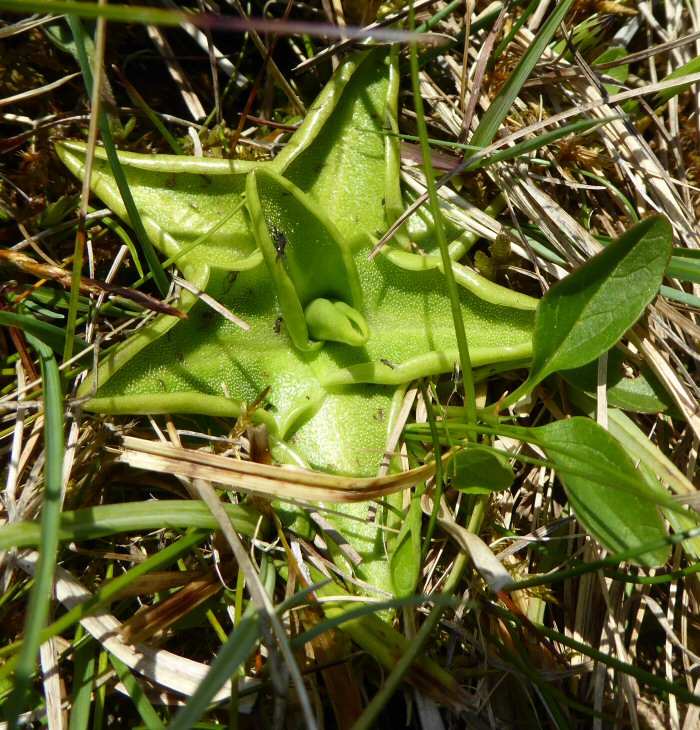
CES 301
Sunday, May 6th 2018
After freezing on Monday today was warm, almost hot, sunny, a gentle breeze - just perfect for CES 1. The ringing team arrived for a 0530 start when the dawn was just breaking. I make no excuses for starting the photographs with a sun rise - something that I haven't been able to do since last year!

Greylag Geese were flying overhead calling loudly, as the nets were opened.

At this time of year the females are sitting on their nests, so most of the birds caught are males. This beautiful Blackcap was one of six of the species caught today.

Whilst some members stayed at Foxglove others set off onto the training area to check more owl boxes. I know Barn Owls have featured recently but this is such a spectacular owl - a beautiful female - must have its place on the blog.

Whilst they were out a Lapwing was also caught on camera,

and its chicks were ringed.

In amongst the birds retrapped was a Willow Warbler that was first ringed, as an adult in June 2015. In July 2014, a Blue Tit was ringed as a juvenile and a Robin ringed in September 2012 as a juvenile - both were caught again today.
A huge thank you to the ringing team and to the visitor who kindly took our photograph. It was an eventful day with 120 birds caught: our 301st CES day - the first of the 2018 season. It brought the total of new birds ringed on the reserve to 61,001.

Round Two of Foxglove Owl Boxes
Friday, May 4th 2018
It has been a very warm day on the Reserve today, the Blackthorn blossom near to the Vole Ponds has been particularly dazzling when the sun has been shining, giving off the impression of being in an extremely prickly cloud.
.jpg)
But enough about weather and blossom and onto the main event of the day, checking the Owl boxes at Foxglove Covert.
We returned to a nest box which was last surveyed on the 27th April by Stacey, Jenny and Rachel. After Mother Owl departed Stacey quickly fetched three of the four chicks to ring (the fourth still being too small).
This little chap seemed well content dozing in the sunshine…
.jpg)
We then headed over to a nest box on the moor, where we were unsuccessful in ringing a Barn Owl last time. Lo and behold we found a new visitor to the reserve. This female Barn Owl has now been ringed and was not alone in her box, being joined by three eggs (fingers crossed!).

Next we headed back to a box where we recorded a female Tawny Owl on the 27th April and noted her three chicks that were too small to be ringed at that time. This time however the two remaining chicks were large enough and have now also been ringed.
Last night’s Owl box round-up
Thursday, May 3rd 2018
Converging on Wathgill around 18:15 we were off to a flying start, finding a Tawny Owl with 3 eggs in the woods round the back. I must apologise to all Tawny Owl fans as I have no picture to show for our exploits!
The next two boxes were frequented by Jackdaws, which had 5 and 7 eggs between them. Our next port of call was a couple of Dipper nests, one of which is no longer accessible, the other of which had 5 eggs and will require a return visit.

Our fourth Owl box stop was at Stainton Green Barn, a particularly challenging box to survey due to its position in the rafters and the need to have multiple exits covered.

This box proved well worth the trouble and is now home to a pair of Barn Owls that were first ringed together three years ago (GN47046; female; left and GN47047; male; right)

Alongside these pair of beauties were five eggs! Both Owls are old hat to the whole process and dozed throughout, offering a picture perfect example of the differences between the two sexes.

After such a great success story we had three boxes of less interest in a row (Jackdaw, unsuccessful Tawny and Squirrels) before finding another female Tawny Owl with one chick in the box at Eddy's Bridge.
Although we didn't find anything in the box at High Insque, we did find a carpeting of Bluebells waiting for us.

A further three Owl boxes were checked after HIgh Insque before we lost the light, with the last proving most interesting. The female Kestrel in the box above Downholme was sitting on five eggs and was yet another to return to the area year on year. It was first ringed as a chick in the box at Hudswell Grange.
All in all 15 Owl boxes were checked in one night, 14 around Wathgill, Stainton and Downholme, and another checked by Sophie.
How best to start your day but in the garden after all the excitement of the night before where we were reducing the amount of Bistort in the main flower bed and making a few new additions.
The hardy Cyclamen species coum and hederifolium have been added to provide a valuable source of pollen and nectar in the Spring and Autumn, along with Chinese Chives (Allium tuberosum) which flower during the late Summer period. By planting these species we are hoping to provide food sources for invertebrates and vibrance to the garden throughout the year.

Yarm Prep. School visits Foxglove
Wednesday, May 2nd 2018
Yarm Prep. School joined us today for Pond Dipping, Signs of Spring walks, and Practical Conservation Tasks.

After a mid morning biscuit break all three groups headed down the Scrapes before splitting up and cracking on with their respective activities.

Mr Pearce took a lead on Pond Dipping, with all three groups finding a plethora of different, interesting species; from Caddisfly larvae, to Whirligig Beetles and Water Boatman.

Team Ian focused on finding the signs of Spring, of which many are now starting to wane. Primroses are still prevalent throughout the Reserve, and the Bluebells are now starting to flower in many of the more sheltered areas.
Between the morning and afternoon sessions the Mallard on her nest down in Risedale Beck saw a few new arrivals as her eggs hatched and the young chicks were seen making their way upstream with mother duck around 1300.

Steve's groups were put in charge of the Reserve's practical work for the day; using tree ties to affix saplings to stakes in the hope that they stay the right way up!


Everyone had a great time, with Pond Dipping proving the most well-loved activity yet again; although I did hear lunch being mentioned as the best activity of the day too!

I would like to say a big thank you to Yarm Prep. School from everyone here at Foxglove, you're welcome back anytime!
Hidden Heaths
Tuesday, May 1st 2018
It's been another busy day at Foxglove where we were joined by our friends from the Dales School, and also by Spring Hill School, Ripon.
Aside from these visits our Tuesday Reserve Volunteers have been busy looking after some of what I've started to call our Mini Heaths; areas outside of the Heathland paddocks rich in Heathland vegetation.
Many of these areas have a Heather-based understorey covered by Hawthorn, Willow and Gorse. Much of the work carried out today has involved removing Gorse, which when left unchecked soon shades out the Heather and takes over completely.
Aside from removing Gorse we have also been crown lifting the overstorey in some places to allow more light to reach the floor and give the Heather a chance of making a comeback where it has been shaded out in the past.

We also found two Juniper bushes hidden away and at risk of falling beneath Gorse, Willow and Hawthorn; one of which is a very impressive specimen, with a reach of approximately 2 meters from trunk to branch tips.



